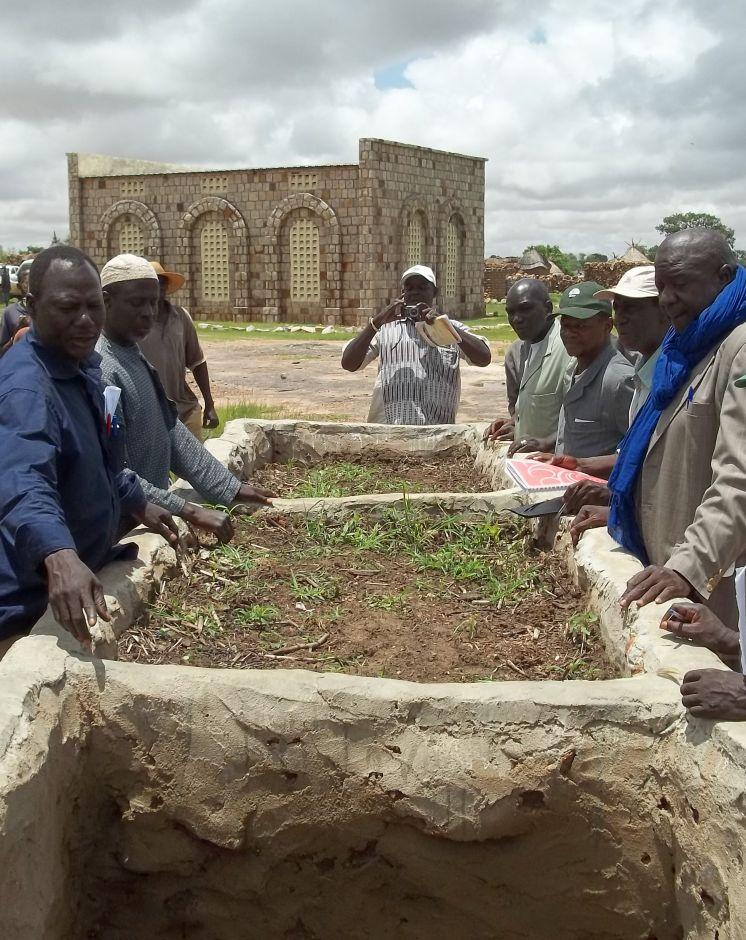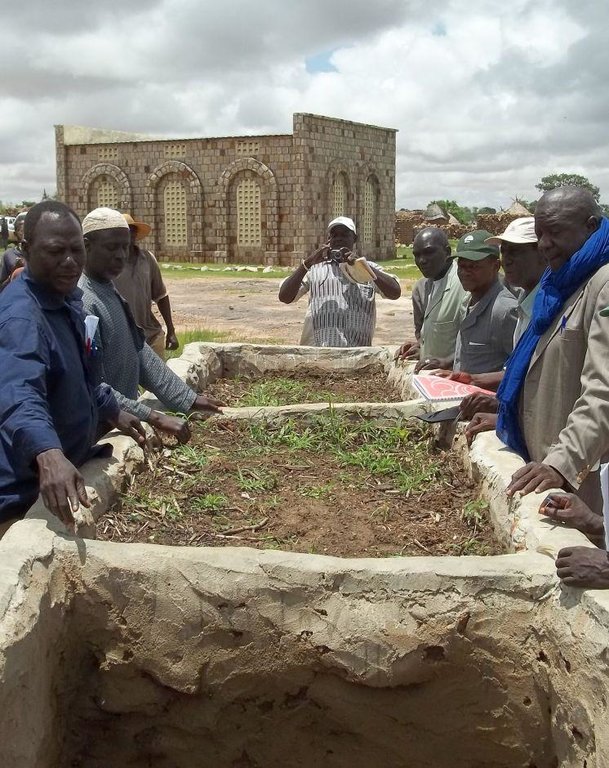Using organic fertilizers on small-scale irrigation plots [马里]
- 创建:
- 更新:
- 编制者: Dieter Nill
- 编辑者: –
- 审查者: David Streiff, Alexandra Gavilano
Apport de fumure organique dans les parcelles de petite irrigation (French)
technologies_1228 - 马里
查看章节
全部展开 全部收起1. 一般信息
1.2 参与该技术评估和文件编制的资源人员和机构的联系方式
SLM专业人员:
Dako Jean Parfait
National Directorate of Agriculture
马里
有助于对技术进行记录/评估的项目名称(如相关)
Good Practices in Soil and Water Conservation - A contribution to adaptation and farmers ́ resilience towards climate change in the Sahel (GIZ)有助于对技术进行记录/评估的机构名称(如相关)
Deutsche Gesellschaft für Internationale Zusammenarbeit (GIZ) GmbH (GIZ) - 德国有助于对技术进行记录/评估的机构名称(如相关)
United Nations Development Program (United Nations Development Program) - 塔吉克斯坦1.3 关于使用通过WOCAT记录的数据的条件
编制者和关键资源人员接受有关使用通过WOCAT记录数据的条件。:
是
1.4 所述技术的可持续性声明
这里所描述的技术在土地退化方面是否存在问题,导致无法被认为是一种可持续的土地管理技术?:
否
2. SLM技术的说明
2.1 技术简介
技术定义:
Organic fertiliser enhances the productivity of the soil, as well as its capacity for infiltration and water retention.
2.2 技术的详细说明
说明:
Smallholding farmland lends itself to market gardening and rice and maize growing. Applying five tonnes of organic fertiliser per hectare for cereal growing and 20 tonnes per hectare for vegetable growing significantly improves soil fertility in small-scale irrigation schemes. The most commonly used organic fertilisers are: compost; straw pen manure with litter or household waste.
Purpose of the Technology: The objective of using organic fertiliser is to enhance productivity by improving the structure and fertility of the soil, as well as its capacity for infiltration and water retention. It stimulates biological activity in the soil and increases yields and production. Increasing the level of organic matter in the soil (humus) enhances its capacity to store nutrients (cation-exchange capacity) and water.
Establishment / maintenance activities and inputs: Farming advisors provide producers with training on techniques for preparing and applying the different types of organic fertiliser.
Composting: The actions required are: digging the composting pit; filling the pit; looking after the pit; applying the compost to the land.
The composting pit: the collection and stockpiling of straw pen manure; the application of the manure to the land.
Household waste: The collection and stockpiling of household waste; the application of the household waste to the land.
Farming advisors monitor how growers produce and apply organic fertiliser. Growers dig the composting and slurry pits, transport organic matter to fill the pits, and manage the upkeep and oversight of the pits.
The frequency of organic fertiliser application varies from once a year to every three years and depends on its quality and quantity.
This activity requires basic equipment (cart, wheelbarrow) to transport the organic matter.
Natural / human environment: This practice is being popularised throughout the areas in and around irrigation schemes throughout Mali.
2.3 技术照片
2.5 已应用该技术的、本评估所涵盖的国家/地区/地点
国家:
马里
区域/州/省:
Mali
注释:
The practice is being popularised throughout the areas in and around irrigation schemes.
Map
×2.6 实施日期
如果不知道确切的年份,请说明大概的日期:
- 不到10年前(最近)
2.7 技术介绍
详细说明该技术是如何引入的:
- 通过项目/外部干预
注释(项目类型等):
Ongoing for around 10 years
3. SLM技术的分类
3.1 该技术的主要目的
- access to fertilizer
3.2 应用该技术的当前土地利用类型
同一土地单元内混合使用的土地::
是
具体说明混合土地使用(作物/放牧/树木):
- 农牧业(包括农牧结合)

农田
- 一年一作
- rice
每年的生长季节数:
- 1
具体说明:
Longest growing period in days: 120; Longest growing period from month to month: August-November

牧场
注释:
Major land use problems (compiler’s opinion): soil fertility decline, low capacity for infiltration and water retention
Livestock density: 1-10 LU /km2
3.4 供水
该技术所应用土地的供水:
- 混合雨水灌溉
3.5 该技术所属的SLM组
- 土壤肥力综合管理
3.6 包含该技术的可持续土地管理措施

农艺措施
- A2:有机质/土壤肥力
注释:
Type of agronomic measures: manure / compost / residues
3.7 该技术强调的主要土地退化类型

化学性土壤退化
- Cn:肥力下降和有机质含量下降(非侵蚀所致)

生物性退化
- Bq:数量/生物量减少

水质恶化
- Ha:干旱化
注释:
Main causes of degradation: crop management (annual, perennial, tree/shrub), droughts, population pressure
3.8 防止、减少或恢复土地退化
具体数量名该技术与土地退化有关的目标:
- 减少土地退化
- 修复/恢复严重退化的土地
4. 技术规范、实施活动、投入和成本
4.1 该技术的技术图纸
技术规范(与技术图纸相关):
Technical knowledge required for field staff / advisors: moderate
Technical knowledge required for land users: low
Main technical functions: improvement of ground cover, improvement of surface structure (crusting, sealing), improvement of topsoil structure (compaction), increase in organic matter, increase in nutrient availability (supply, recycling,…), increase of biomass (quantity), promotion of vegetation species and varieties (quality, eg palatable fodder)
Secondary technical functions: control of raindrop splash, increase of infiltration, increase / maintain water stored in soil
4.5 维护/经常性活动
| 活动 | 时间/频率 | |
|---|---|---|
| 1. | looking after the pit | |
| 2. | The collection and stockpiling of straw pen manure or household waste | |
| 3. | applying the compost/household waste to the land |
4.6 维护/经常性活动所需要的费用和投入(每年)
注释:
Machinery/ tools: basic equipment (cart, wheelbarrow) to transport the organic matter
4.7 影响成本的最重要因素
描述影响成本的最决定性因素:
Production costs are low given that the local materials involved are available freely or at very low cost. This activity requires basic equipment (cart, wheelbarrow) to transport the organic
matter.
5. 自然和人文环境
5.1 气候
年降雨量
- < 250毫米
- 251-500毫米
- 501-750毫米
- 751-1,000毫米
- 1,001-1,500毫米
- 1,501-2,000毫米
- 2,001-3,000毫米
- 3,001-4,000毫米
- > 4,000毫米
农业气候带
- 半干旱
Thermal climate class: tropics
5.2 地形
平均坡度:
- 水平(0-2%)
- 缓降(3-5%)
- 平缓(6-10%)
- 滚坡(11-15%)
- 崎岖(16-30%)
- 陡峭(31-60%)
- 非常陡峭(>60%)
地形:
- 高原/平原
- 山脊
- 山坡
- 山地斜坡
- 麓坡
- 谷底
垂直分布带:
- 0-100 m a.s.l.
- 101-500 m a.s.l.
- 501-1,000 m a.s.l.
- 1,001-1,500 m a.s.l.
- 1,501-2,000 m a.s.l.
- 2,001-2,500 m a.s.l.
- 2,501-3,000 m a.s.l.
- 3,001-4,000 m a.s.l.
- > 4,000 m a.s.l.
5.3 土壤
平均土层深度:
- 非常浅(0-20厘米)
- 浅(21-50厘米)
- 中等深度(51-80厘米)
- 深(81-120厘米)
- 非常深(> 120厘米)
土壤质地(表土):
- 中粒(壤土、粉土)
- 细粒/重质(粘土)
表土有机质:
- 中(1-3%)
- 低(<1%)
如有可能,附上完整的土壤描述或具体说明可用的信息,例如土壤类型、土壤酸碱度、阳离子交换能力、氮、盐度等。:
Soil fertility is medium
Soil drainage / infiltration is poor - medium
Soil water storage capacity is medium
5.4 水资源可用性和质量
地下水位表:
5-50米
地表水的可用性:
中等
水质(未处理):
仅供农业使用(灌溉)
关于水质和水量的注释和进一步规范:
Availability of surface water: medium, poor/ none
5.5 生物多样性
物种多样性:
- 中等
5.6 应用该技术的土地使用者的特征
生产系统的市场定位:
- 混合(生计/商业)
非农收入:
- 收入的10-50%
相对财富水平:
- 贫瘠
- 平均水平
机械化水平:
- 手工作业
性别:
- 男人
说明土地使用者的其他有关特征:
Population density: < 10 persons/km2
Annual population growth: 2% - 3%
10% of the land users are rich.
50% of the land users are average wealthy.
30% of the land users are poor.
10% of the land users are poor.
5.7 应用该技术的土地使用者使用的平均土地面积
- < 0.5 公顷
- 0.5-1 公顷
- 1-2 公顷
- 2-5公顷
- 5-15公顷
- 15-50公顷
- 50-100公顷
- 100-500公顷
- 500-1,000公顷
- 1,000-10,000公顷
- > 10,000公顷
这被认为是小规模、中规模还是大规模的(参照当地实际情况)?:
- 小规模的
5.8 土地所有权、土地使用权和水使用权
注释:
The irrigated land is allocated by the chief
5.9 进入服务和基础设施的通道
健康:
- 贫瘠
- 适度的
- 好
教育:
- 贫瘠
- 适度的
- 好
技术援助:
- 贫瘠
- 适度的
- 好
就业(例如非农):
- 贫瘠
- 适度的
- 好
市场:
- 贫瘠
- 适度的
- 好
能源:
- 贫瘠
- 适度的
- 好
道路和交通:
- 贫瘠
- 适度的
- 好
饮用水和卫生设施:
- 贫瘠
- 适度的
- 好
金融服务:
- 贫瘠
- 适度的
- 好
6. 影响和结论性说明
6.1 该技术的现场影响
社会经济效应
生产
作物生产
生产故障风险
生产区域
水资源可用性和质量
灌溉用水需求
收入和成本
农业投入费用
农业收入
社会文化影响
食品安全/自给自足
SLM/土地退化知识
livelihood and human well-being
注释/具体说明:
Applying five tonnes of organic fertiliser per hectare for cereal growing and 20 tonnes per hectare for vegetable growing significantly improves soil fertility in small-scale irrigation schemes
生态影响
土壤
土壤水分
土壤覆盖层
土壤流失
土壤结壳/密封
土壤压实
养分循环/补给
土壤有机物/地下C
生物多样性:植被、动物
生物量/地上C
减少气候和灾害风险
干旱影响
其它生态影响
capacity to store nutrients and water
6.2 该技术的场外影响已经显现
下游洪水
下游淤积
风力搬运沉积物
对邻近农田的破坏
6.3 技术对渐变气候以及与气候相关的极端情况/灾害的暴露和敏感性(土地使用者认为的极端情况/灾害)
渐变气候
渐变气候
| 季节 | 增加或减少 | 该技术是如何应对的? | |
|---|---|---|---|
| 年温度 | 增加 | 好 |
气候有关的极端情况(灾害)
气象灾害
| 该技术是如何应对的? | |
|---|---|
| 局地暴雨 | 不好 |
| 局地风暴 | 不好 |
气候灾害
| 该技术是如何应对的? | |
|---|---|
| 干旱 | 好 |
水文灾害
| 该技术是如何应对的? | |
|---|---|
| 比较和缓的(河道)洪水 | 不好 |
其他气候相关的后果
其他气候相关的后果
| 该技术是如何应对的? | |
|---|---|
| 缩短生长期 | 好 |
6.4 成本效益分析
技术收益与技术建立成本相比如何(从土地使用者的角度看)?
短期回报:
积极
长期回报:
非常积极
技术收益与技术维护成本/经常性成本相比如何(从土地使用者的角度看)?
短期回报:
非常积极
长期回报:
非常积极
6.7 该技术的优点/长处/机会
| 编制者或其他关键资源人员认为的长处/优势/机会 |
|---|
| Maintains soil fertility and improves its structure |
| Stimulates biological activity in the soil and increases yields and production |
| Increasing the level of organic matter in the soil (humus) enhances its capacity to store nutrients (cation-exchange capacity) and water |
|
Organic fertiliser is less expensive than chemical fertilizer. Production costs are low given that the local materials involved are available freely or at very low cost. |
6.8 技术的弱点/缺点/风险及其克服方法
| 编制者或其他关键资源人员认为的弱点/缺点/风险 | 如何克服它们? |
|---|---|
| Lack of equipment for collecting organic matter and water shortages in the dry season | |
| Particularly in semi-arid areas, not enough biomass is available to systematically provide the quantities required to cover all the land being farmed. Compost is therefore often reserved for cash crops. | |
| This activity requires basic equipment (cart, wheelbarrow) to transport the organic matter. |
7. 参考和链接
7.1 信息的方法/来源
- 实地考察、实地调查
- 与土地使用者的访谈
(现场)数据是什么时候汇编的?:
01/07/2012
7.2 参考可用出版物
标题、作者、年份、ISBN:
Manual of Good Practices in Small Scale Irrigation in the Sahel. Experiences from Mali. Published by GIZ in 2014.
可以从哪里获得?成本如何?
http://star-www.giz.de/starweb/giz/pub/servlet.starweb
标题、作者、年份、ISBN:
Technical fact sheets on organic fertiliser (DNA)
链接和模块
全部展开 全部收起链接
无链接
模块
无模块




